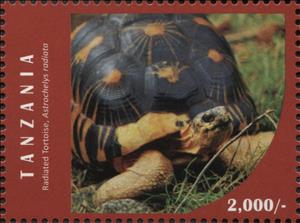Stamp: Radiated Tortoise (Astrochelys radiata) (Tanzania 2016)
Radiated Tortoise (Astrochelys radiata) (Tanzania 2016)
28 January (Tanzania ) within release Endangered Animals of Africa (2016) goes into circulation Stamp Radiated Tortoise (Astrochelys radiata) face value 2,000 Tanzanian shilling
| Stamp Radiated Tortoise (Astrochelys radiata) in catalogues | |
|---|---|
| Michel: | Mi: TZ 5230 |
| WADP Numbering System - WNS: | WAD: TZ 046.16 |
Stamp is horizontal format.
Although authorised by the Tanzanian Postal Administration this issue was only distributed by Tansania's philatelic agency to the novelty trade.Also in the issue Endangered Animals of Africa (2016):
- Mini Sheet - Endangered Animals of Africa face value 4*2000;
- Stamp - Grevy's Zebra (Equus grevyi) face value 2,000;
- Stamp - African Penguin (Spheniscus demersus) face value 2,000;
- Stamp - Rothschild's Giraffe (Giraffa camelopardalis rothschildi) face value 2,000;
- Stamp - Western Lowland Gorilla (Gorilla gorilla gorilla) face value 2,000;
- Mini Sheet - Endangered Animals of Africa face value 4*2000;
- Stamp - Greater Bamboo Lemur (Prolemur simus) face value 2,000;
- Stamp - Radiated Tortoise (Astrochelys radiata) face value 2,000;
- Stamp - Dama Gazelle (Nanger dama) face value 2,000;
- Stamp - African Wild Dog (Lycaon pictus) face value 2,000;
- Stamp - Black Rhinozeros (Diceros bicornis) face value 3,000;
- Stamp - Mountain Gorilla (Gorilla beringei beringei) face value 3,000;
- Stamp - Addax (Addax nasomaculatus) face value 3,000;
- Stamp - Geometric Tortoise (Psammobates geometricus) face value 3,000;
- Souvenir Sheet - Endangered Animals of Africa face value 2*3000;
- Souvenir Sheet - Endangered Animals of Africa face value 2*3000;
Stamp Radiated Tortoise (Astrochelys radiata) it reflects the thematic directions:
Animals are multicellular, eukaryotic organisms of the kingdom Animalia (also called Metazoa). All animals are motile, meaning they can move spontaneously and independently, at some point in their lives. Their body plan eventually becomes fixed as they develop, although some undergo a process of metamorphosis later on in their lives. All animals are heterotrophs: they must ingest other organisms or their products for sustenance.
Reptiles are tetrapod (four-limbed vertebrate) animals in the class Reptilia, comprising today's turtles, crocodilians, snakes, amphisbaenians, lizards, tuatara, and their extinct relatives. The study of these traditional reptile orders, historically combined with that of modern amphibians, is called herpetology. Because some reptiles are more closely related to birds than they are to other reptiles (e.g., crocodiles are more closely related to birds than they are to lizards), the traditional groups of "reptiles" listed above do not together constitute a monophyletic grouping (or clade). For this reason, many modern scientists prefer to consider the birds part of Reptilia as well, thereby making Reptilia a monophyletic class.
Turtles are reptiles of the order Testudines, characterized by a special shell developed mainly from their ribs. Modern turtles are divided into two major groups, the Pleurodira (side necked turtles) and Cryptodira (hidden necked turtles), which differ in the way the head retracts. There are 360 living and recently extinct species of turtles, including land-dwelling tortoises and freshwater terrapins. They are found on most continents, some islands and, in the case of sea turtles, much of the ocean. Like other amniotes (reptiles, birds, and mammals) they breathe air and do not lay eggs underwater, although many species live in or around water.



